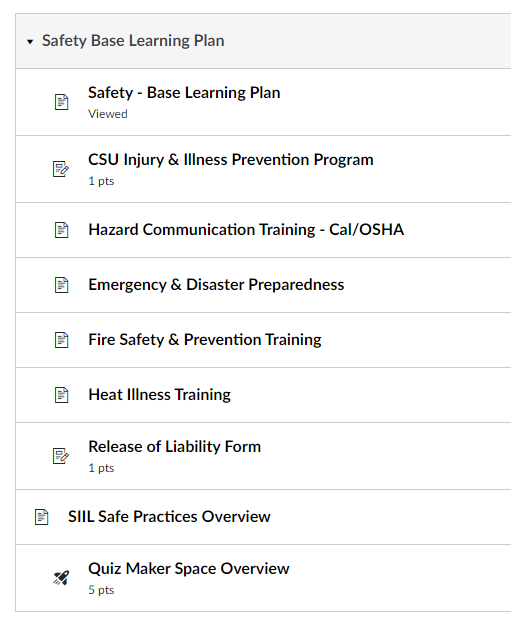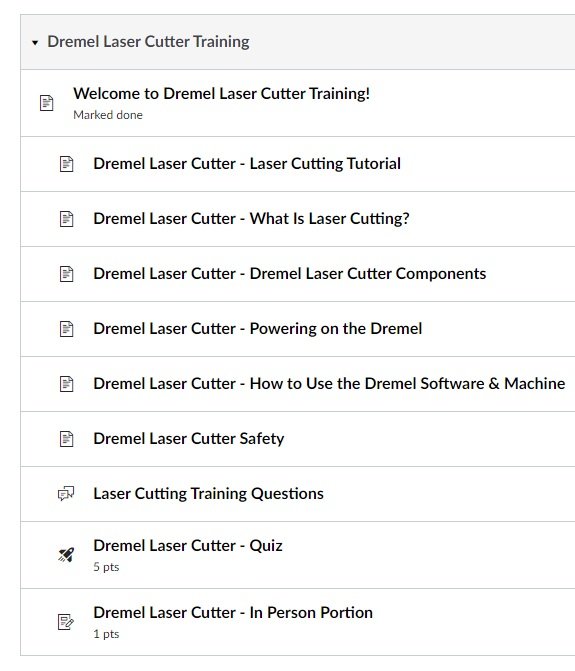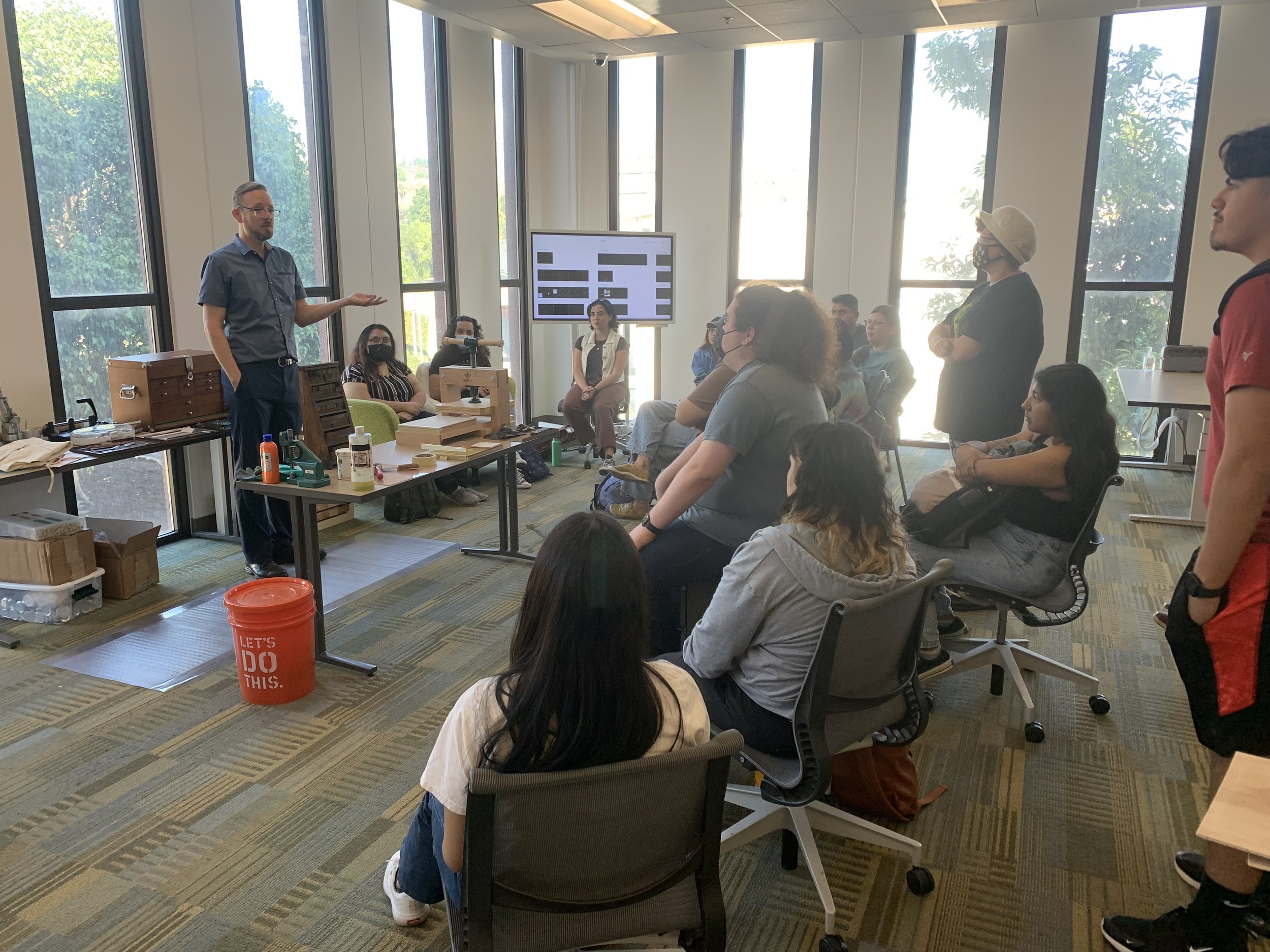Teaching in the Maker Studio Part Two: Safety Training and Open Making
Posted by Kate Ozment
This post is part of a series covering workshops in a single course called Technologies of Writing. For an overview, see this post.
This week and next, the Maker Studio staff and I had the task of training 25 students to use equipment safely, promote a general interest in making, and help them complete fabricating a basic soft-cover book. It took four total class periods, 75 minutes each, with this week focused on training. This post is going to cover how we structure safety training and hands-on training through the Maker Studio, and how the staff and I worked together to get students comfortable in this space and able to use it safely. This is going to be more technical than most of my posts, but this is something I’ve had to learn over the years and I hope it’s helpful as a model for others who are doing this work.
The Maker Studio is a part of the Student Innovation Idea Labs, which runs three maker spaces in the CPP community. The Maker Studio was opened in Fall 2019 and it lives in the library. It’s a free space for students to make things, and it’s student-volunteer run. The space includes a lot of equipment such as 3D printers, laser cutters, sewing and embroidery machines, a vinyl cutter, VR equipment, a 3D scanner, collaboration tools like moveable whiteboards, zine-making materials, an Axi-Draw, and a mini letterpress studio. It’s a pretty great space, but it can be overwhelming, especially for humanities majors who are not used to thinking about substrate composition when 3D printing a snail.
To train 25 students, I coordinated with the studio staff who asked if any volunteers wanted to come train and several came to help. In addition to the general safety training required by the Cal State system, we identified four areas where students might develop skills they could use in my class:
3D Printers
Laser Cutter
Vinyl Cutter
Letterpress
The Maker Studio runs training in two parts: students get access to a Canvas shell that has modules with videos and lectures on safety. Above are two examples. After working through the material, students must get a 100 on a quiz to pass online training. There are discussion boards where folks can ask questions about the training, which Maker Studio staff responds to. We batch-added my 25 students to this course with their IDs, and they were told to have four trainings completed online by class on Monday: general safety training and 3D printers, laser cutter, and vinyl cutter. If all trainings were complete, they’d get their practical training done during our course. If they did not have them done, they were told to use a library computer and work on it during course.
For practical training, I run the letterpress, so I needed help with the other three. An ambassador or staff member took each station. We had 16 students complete training on time, so we worked in groups of four. Practical training is what it sounds like: put into action what you saw online. All machines are best learned through practice, so the goal was to decrease the mental hurdle to try something new like 3D printing or a laser cutter.
For day two, we continued to work on training and got students working on the letterpress. Students who had completed their online training during last week’s class had their hands-on during this one. If they still weren’t done, they were told the had to come back on the Maker Studio’s schedule to complete training. The 16 who were ready to letterpress were with me and we worked on that together. I’m going to cover the details of this in a separate post, readable here.
In our downtime between letterpress printing over the next two days (as 25 students can’t work one book beetle at a time), we had “open making time” which was designed to encourage students to play around and get used to working with their hands. A few immediately jumped on the laser cutter, and most got into the arts and crafts to play with Floof, pipe cleaners, or paper crafts. This down time let them get comfortable in the space and think about the many ways we “write” with our hands.
Reflection
As their wrap-up assignment, students were asked to do the following:
This week, we learned how to make things in the Maker Studio, which required pre-workshop training online and hands-on work with the Maker Studio ambassadors.
What was the biggest challenge of working with these tools? Or, what were you nervous about?
What was something exciting or something you are glad you got to learn?
Do you recognize any similarities between Maker Studio equipment and what we've seen from older periods? Think broadly here, about the basic logic of substrates, pigments, tools, etc.
How might you use the Maker Studio to create something bookish? In the broadest sense.
About the Author
Kate Ozment is assistant professor of English at California State Polytechnic University, Pomona. She has a book on Hroswitha Club forthcoming from Cambridge UP’s Elements series, and you can find her other work in Textual Cultures, Eighteenth-Century Studies, and Digital Humanities Quarterly. Contact her at: keozment (at) cpp (dot) edu.
-
October 2022
- Oct 16, 2022 Teaching in the Maker Studio Part Two: Safety Training and Open Making
- Oct 16, 2022 Teaching Book Forms
- Oct 16, 2022 Teaching Letterpress with the Bookbeetle Press
-
September 2022
- Sep 24, 2022 Making a Scriptorium, or, Writing with Quills Part Two
- Sep 16, 2022 Teaching Cuneiform
- Sep 4, 2022 We're Back! Teaching Technologies of Writing
-
June 2020
- Jun 1, 2020 Black Lives Matter
- May 2020
-
April 2020
- Apr 1, 2020 Teaching Materiality with Virtual Instruction
- March 2020
-
February 2020
- Feb 1, 2020 Making the Syllabus Zine
-
January 2020
- Jan 1, 2020 Teaching Print History with Popular Culture
-
December 2019
- Dec 1, 2019 Teaching with Enumerative Bibliography
-
November 2019
- Nov 1, 2019 Finding Women in the Historical Record
-
October 2019
- Oct 1, 2019 Teaching in the Maker Studio
-
September 2019
- Sep 1, 2019 Graduate School: The MLS and the PhD
-
August 2019
- Aug 1, 2019 Research Trips: Workflow with Primary Documents
-
July 2019
- Jul 1, 2019 Research Trips: A Beginner's Guide
-
June 2019
- Jun 1, 2019 Building a Letterpress Reference Library
-
May 2019
- May 1, 2019 Teaching Manuscript: Writing with Quills
-
April 2019
- Apr 1, 2019 Why It Matters: Teaching Women Bibliographers
- March 2019
-
February 2019
- Feb 1, 2019 Roundup of Materials: Teaching Book History
-
January 2019
- Jan 1, 2019 Building and Displaying a Teaching Collection
-
December 2018
- Dec 1, 2018 Critical Making and Accessibility
-
November 2018
- Nov 1, 2018 Teaching Bibliographic Format
-
October 2018
- Oct 1, 2018 Teaching Book History Alongside Literary Theory
-
September 2018
- Sep 1, 2018 Teaching with Letterpress
-
August 2018
- Aug 1, 2018 Teaching Manuscript: Circulation
-
July 2018
- Jul 1, 2018 Setting Up a Print Shop
-
May 2018
- May 1, 2018 Teaching Manuscript: Commonplace Books
-
April 2018
- Apr 1, 2018 Getting a Press
-
March 2018
- Mar 1, 2018 Teaching Ephemera: Pamphlet Binding
- February 2018





